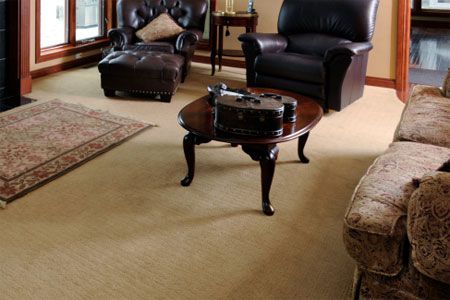Project details
Skill
Cost
Estimated Time
Installing carpet can transform a room, adding warmth, comfort, and style. It’s a big project, but with the right tools and techniques, you can successfully install carpeting yourself. Our guide will walk you through the process step-by-step, including preparing the subfloor, installing the padding, laying tack strips, stretching the carpet into place, and completing the finishing touches.
Essential Tools and Materials for Carpet Installation
To install carpeting successfully, you’ll need the following tools and materials. These are not items you likely have in your toolbox or garage—you’ll need to rent them or make an additional purchase.
- Tack strips and stapler: Tack strips are thin pieces of wood with angled pins that grip the carpet and hold it in place around the room’s perimeter. A stapler secures the carpet padding to the subfloor. Both are essential for a secure and long-lasting carpet installation.
- Power stretcher and knee kicker: A power stretcher is needed for installing carpet in large rooms (anything 10-by-10 feet or larger), as it helps pull the carpet tight and eliminate wrinkles and bumps. For smaller areas and initial placement, a knee kicker will do the trick. These tools work together to ensure your carpet is properly stretched and secured.
- Carpet edging tool: A carpet edging tool creates smooth transitions between carpet and other flooring types, particularly in doorways. It also secures the carpet edges and prevents fraying, ensuring a polished and professional finish
- Carpet chisel: A carpet chisel has a wide, flat blade that tucks the carpet into tight spaces and secures it against walls, along tack strips, and in corners. It’s particularly useful for fitting the carpet snugly under baseboards and around edges.
- Carpet trimmer or utility knife: A carpet trimmer allows for precise cutting along walls and around obstacles. While some professionals use a utility knife, a dedicated trimmer is less likely to damage baseboards or the subfloor. Keep extra blades on hand for both tools to ensure clean cuts throughout the installation process.
- Electric seaming iron, seaming weight, and heat-activated seam tape: If you need to attach two pieces of carpet together, you’ll need these items to create a smooth, seamless appearance. You will likely need to join pieces of carpet if you’re working on a large room that exceeds the width of the carpet roll.
Preparing the Room for Carpet Installation
After choosing your carpeting, it’s time to prepare the room. Follow these steps to make the process go smoothly.
Remove the Old Flooring
Begin by clearing the room of all furniture and removing any existing flooring, including old carpet, padding, and tack strips, so that you have a clean, bare subfloor to work with.
Inspect and Repair the Subfloor
Carefully inspect the subfloor for damage, unevenness, or loose boards. Repair any problems you find, as they can affect the quality of your carpet installation. Fill cracks, tighten loose boards, and sand down high spots to create a smooth, level surface for your new carpet.
In the video below, Kevin O’Connor demonstrates a wall-to-wall carpet installation.
Tips for Measuring and Cutting Carpet
Accurate measurement and cutting are crucial steps in carpet installation. If your carpet has a pattern, plan your cuts carefully to ensure the pattern aligns properly across seams and at walls. Add extra length to allow for pattern matching, typically three to six inches, depending on the pattern repeat.
Additionally, you should always cut your carpet slightly larger than the room dimensions, typically adding 3–4 inches on each side. This extra material allows for proper stretching and tucking. It’s better to have a little excess that you can trim away than to come up short.
Step-by-Step Guide for Installing Carpet
Now, you’re ready to start your installation.
1. Install the carpet tack strips
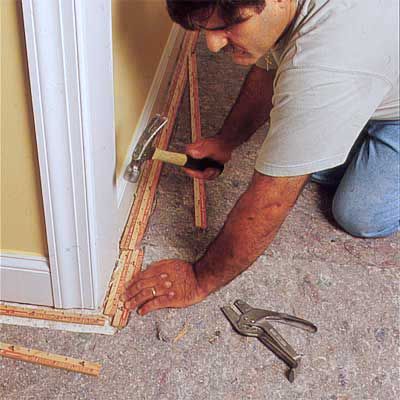
- Begin by covering the wood subfloor with carpet padding. Tack down the padding with a stapler.
- Using a hammer, nail down tack strips around the perimeter of the room. Cut the 1-inch-wide strips to length using a small handsaw or special wood snips. Set the tack strip about 1/2 inch away from the baseboard to allow space for slipping the carpeting underneath.
- One row of tack strips is sufficient to hold down most types of carpeting, but for heavily woven Berbers and woolen carpets, it’s best to install two rows of tack strips side by side. This double-strip trick will provide extra “bite” to prevent the carpeting from pulling loose or shifting out of position.
2. Stretch the carpet

- Unroll the carpeting flat onto the padding. If the carpeting has a particular pattern or texture, be sure it’s oriented correctly in the room. Use a knee kicker to force the carpeting into position against one wall. Move along the wall, striking the kicker with your knee until you’ve pulled out all wrinkles and slack.
- Switch to a lever-activated stretcher to pull the carpet tight to the wall. Use your hand to firmly press the carpeting down onto the pointy spikes of the tack strips below. Check to be sure the oversized carpeting laps up onto each wall by at least a few inches.
3. Trim the edges
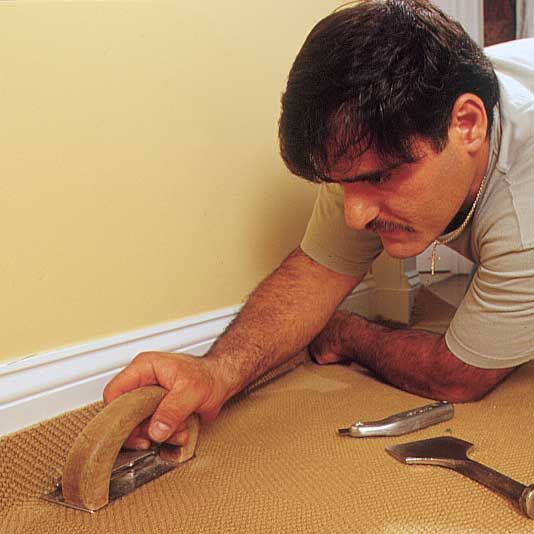
- With the carpeting secured along one wall, use a special carpet-edging tool to trim the carpet flush with the baseboard molding. Keep the metal shoe of the tool pressed tightly against the carpeting, and keep the carpeting tight against the baseboard. (If you don’t have an edging tool, you can trim the carpeting with a utility knife, but be sure to use a brand-new blade and change it as soon as it starts to get dull.)
- Before pulling away the excess strip of carpeting, check to be sure it isn’t still attached at any point. If you pull on the strip while it’s still connected, even if just by a thread, you could unwind a fiber from the carpeting.
4. Push the Edges Under the Baseboard
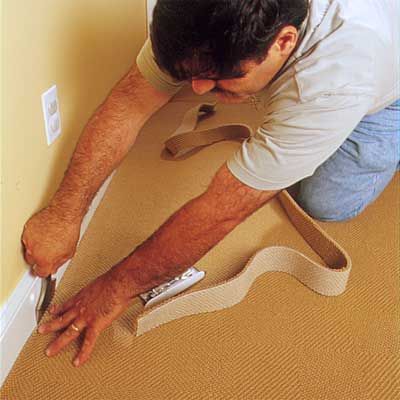
- Use a wide-blade carpet chisel and force the edge of the carpeting into the space beneath the baseboard molding. Be careful not to scratch or dent the molding.
- With the carpeting secured to the tack strips along one wall, move across the room to the opposite wall and repeat the process: force out wrinkles with the knee kicker, pull it taut with the stretcher, then trim away the excess carpeting. For some types of carpeting or in large rooms, you may need a little extra force to pull the carpeting tight. In those cases, attach an extension pole to the lever-activated stretcher and extend the pole across the room so that it pushes against the opposite wall.
- Once the carpeting is secured along two opposite walls, repeat the procedure for attaching and trimming the carpeting along the final two walls.
5. Seam Together Adjoining Pieces
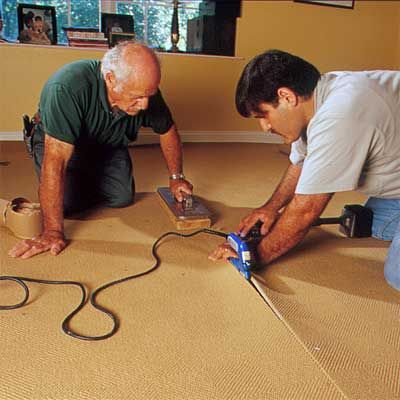
- If you need to seam together two or more pieces of carpeting, you’ll need an electric seaming iron, seaming weight, and a roll of heat-activated seam tape. Plug in the iron and let it heat up. Butt the edges of the two pieces of carpeting tight together, but don’t allow them to overlap.
- Lift up and fold back one edge of carpeting. Slide a length of heat-activated seam tape halfway underneath the edge of carpeting that’s flat on the floor. Run the tape along the entire seam, making sure it’s positioned halfway under the carpeting.
- Lay flat the folded-back piece of carpeting and check for a tight fit along the seam. Starting at one wall, slip the hot seaming iron into the seam. Slowly glide the iron between the two pieces of carpeting, activating the adhesive on the seam tape. Ask a helper to follow closely behind with a seaming weight and firmly press down on the carpet to adhere both edges to the tape.
- As you work your way across the floor, you may have to stop occasionally and use the knee kicker to close up the seam.
6. Carpet the stairs
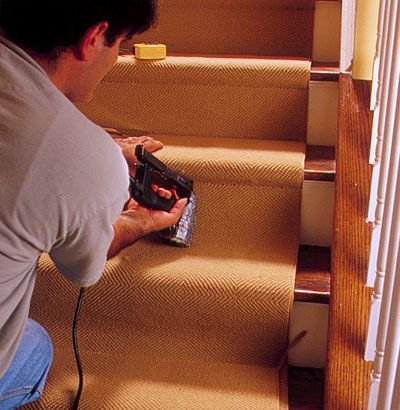
- When carpeting stairs, there are two basic ways to attach the carpet. The traditional cap-and-band method involves running the carpeting down the riser, across the tread, and then tightly wrapping it around the nosing (front edge) of each tread. To hold the carpeting in place, use an electric stapler to tack the carpeting to the underside of the nosing of the treads.
- The second stair-carpeting method, called the waterfall treatment, allows the carpeting to flow from one step to the next without being tucked up under the nosing. The carpeting is tacked down along the rear edge of the tread, right where it meets the riser. The waterfall method imparts a more modern look and works best with carpeting that has smaller patterns.
7. Bind the edges
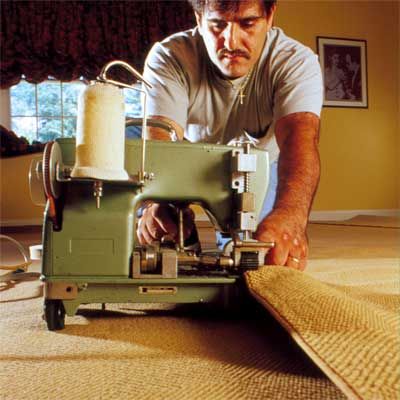
- After the carpeting is cut to fit a set of stairs, you must finish the edges to prevent it from unraveling. One common method is to simply turn under the edges and tack them down to stairs.
- However, to produce a more finished, cleaner look, use a binding machine to finish the edges of the carpeting. The binding machine looks and operates much like a sewing machine and is used to permanently bind the edges. If you can’t find a portable binder, like the one shown here, bring the carpeting to a carpet installer. They typically have one in their shop.
Troubleshooting Common Carpet Installation Issues
Even with careful planning and execution, you may encounter some challenges during carpet installation, including visible seams, ripples, bubbles, or gaps at the edges. Most of these problems can be resolved by re-stretching the carpet, adjusting seams, or trimming and re-tucking edges. If you’re unsure how to address a specific issue, consult a professional to avoid damaging your new carpet.
In the video below, general contractor Tom Silva shares tips on fixing loose carpet.
Maintaining Your Newly Installed Carpet
To keep your newly installed carpet looking its best, establish a regular maintenance routine. Vacuum frequently to remove dirt and debris and address spills promptly to prevent staining. Consider professional deep cleaning every 12–18 months to maintain the carpet’s appearance and extend its lifespan.
